ARTICLE AD BOX
Neuroscientists' monitoring of the brain activity of two Russian-speaking people during writing and speaking allowed them to capture weak signals associated with the work of the person's "inner voice".
“The results of this work expand the knowledge base needed to create neural interfaces that can ‘read thoughts.’ These devices will be able to recognize the user’s thoughts and intentions without knowing whether he wants to move the prosthesis, type text, or perform some other task,” the press office of the Skoltech Institute of Science and Technology said in a statement.
This discovery was made by a group of neurophysiologists headed by Albert Svyanov, head of the Department of Neurosurgery at Sechenov Medical University, while monitoring the brain function of two patients suffering from epilepsy.
During the follow-up, the researchers asked the patients to write a series of numbers on a tablet computer, as well as read a series of words, say them, or imagine themselves saying them out loud. During these activities, the researchers monitored changes in the brain's electrical activity using an electroencephalogram connected to electrodes implanted in their heads.
Analysis and comparison of the measurement results allowed to identify brain areas involved in solving motor problems and producing speech, including the formation of the “inner voice”. It turned out that it can be detected by changes in the activity of several areas within the superior frontal gyrus and the superior temporal gyrus.
The researchers note that the brain activity they detected is relatively weak, but they are confident that it can be separated from noise and other signals using machine learning systems. In the future, they will develop systems that “read the minds” of people with disabilities and allow them to interact more actively with those around them.
.png)
 4 months ago
3
4 months ago
3









 English (US)
English (US)